Some of these old tales about Pomona are actually true. Others are sheer fabrications or exaggerations. Still others remain mysteries. Can you tell which ones are fact, which are fiction, and which are unknown?
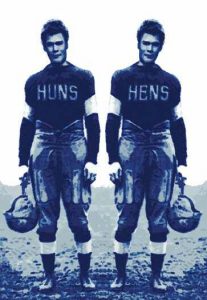 1. Huns to Hens
1. Huns to Hens
Legend has it that Pomona got its unique mascot, the Sagehen, because of a bit of century-old political correctness and some creative cost-avoidance. The original Pomona mascot was far more warlike than the current flightless bird—the Huns. However, that name lost its luster when the U.S. entered World War I in 1917 and the popular epithet for the enemy became you-know-what. The teams had already invested in uniforms bearing the word “HUNS,” so to save money, the “U” was changed to an “E” and they became the “HENS.”
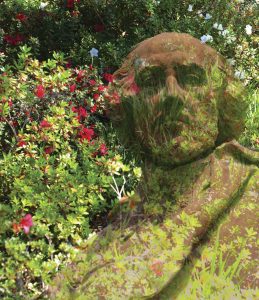 2. The Shakespeare Garden
2. The Shakespeare Garden
Almost every student has heard the story that the border of Marston Quad is home to a garden containing plants mentioned in Shakespeare’s plays—pansies, fennel, willows and rosemary from Hamlet, violets and thyme from A Midsummer Night’s Dream, daffodils from A Winter’s Tale, daisies from Love’s Labour’s Lost, and so on. According to the tale, every plant mentioned in the Bard’s body of work is to be found somewhere in the garden.
 3. Things That Go Bump
3. Things That Go Bump
There are several persistent tales of ghosts on the Pomona campus. There’s Walter, the worker who fell off the roof of Bridges Auditorium during its construction and has haunted the place ever since, playing pranks with the lights and appearing in shadowy passageways. There’s Gwendolyn, who died in the old Claremont Hotel before it became Sumner Hall and occasionally can be seen or heard in its lower level or bell tower. And there’s Nila, the ghost of a young woman who reportedly wanders the attic and hallways of Seaver House.
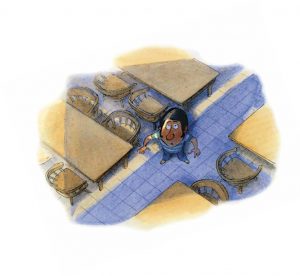 4. The Flying Sailboat
4. The Flying Sailboat
A classic prank that has become Pomona legend happened in 1978. The place was Frary Hall, or rather, the rafters of Frary Hall. In a scene worthy of a Magritte painting, students arriving for breakfast one morning found a 13-foot sailboat suspended in space high above the tables, with sails set and framed in Pomona blue.
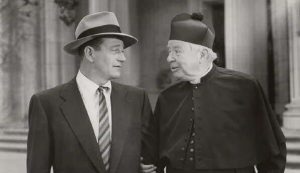 5. The Duke and the Madonna
5. The Duke and the Madonna
Is that Little Bridges behind John Wayne and Charles Coburn in the movie Trouble Along the Way? That, at least, is the story, which includes Wayne coming to campus in 1952 as Pomona played the role of a small Catholic college in the film. That visit is also remembered for a double-take moment when the sculpture of the flutist in the fountain in Lebus Court was covered by a fake statue of the Madonna.
 6. The Borg and the Borg
6. The Borg and the Borg
The story goes that the Borg of TV fame—the swarming, half-cybernetic zombies from Star Trek: The Next Generation who lived in a cube with warrens of maze-like hallways—got its name from Pomona’s Borg—otherwise known as the Oldenborg Center for Modern Languages and International Relations, also known for its warrens of maze-like hallways.
7. Winner and Still Champion…
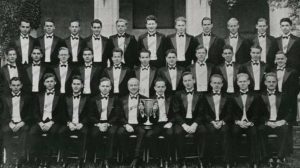
The Men’s Glee Club of 1932 took first place in the Pacific Southwest Glee Club Championship in San Diego, then traveled to St. Louis to compete in the first-ever National Championship, which they won. And since the first National Glee Club Championship also turned out to be the last National Glee Club Championship, Pomona can still lay claim to being the reigning champ.
 8. The Roosevelt Shovel and Oak
8. The Roosevelt Shovel and Oak
According to legend, the shovel that Pomona presidents bring out to break ground for new buildings was used by President Theodore Roosevelt to plant a California live oak on campus during his visit in 1903. Arriving at the Claremont train station, Roosevelt was transported by carriage to campus where he spoke to a throng of 7,000 to 8,000 people from a rostrum in front of Pearsons, later planting the tree, which survives to this day.
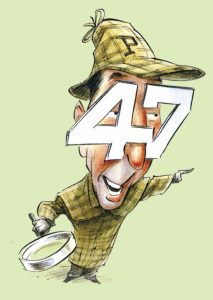 9. All Numbers Equal 47
9. All Numbers Equal 47
The 47 craze at Pomona started in 1964 when Donald Bentley, then Professor of Statistics, presented a paradoxical proof with the title, ”Why all numbers are equal to 47.” Two students in a summer program, Laurens “Laurie” Mets ’68 and Bruce Elgin ’68, then embarked upon their own tongue-in-cheek experiment to determine whether the number 47 occurred more often in nature than other numbers, and the rest is history.
